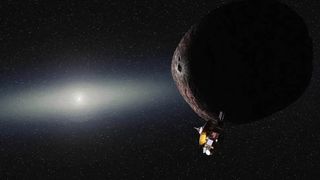stars
Latest about stars

Scientists confirm that most of the universe is 'darkness and nothing more'
By Ben Turner published
Finding the universe's brightness is essential for confirming our theories of what makes up the universe. But to do so, scientists had to send a spacecraft far away from our sun.

James Webb telescope spots 6 enormous 'rogue planets' tumbling through space without a star
By Ben Turner published
The James Webb Space Telescope has uncovered six "rogue planets" careening through space without a star. The objects are believed to have formed directly from gas collapse, blurring the lines between planets and stars.

Watch a star get destroyed by a supermassive black hole in the 1st simulation of its kind
By Daniel Price published
Stars that wander too close to supermassive black holes may be violently undone in a process called "spaghettification." New simulations provide the most detailed look ever at the gory interaction.

Dead stars sometimes shine again — and gravity itself may be responsible
By Paul Sutter published
Do dead stars glow? A strange gravitational phenomenon could be generating enormous amounts of light around neutron stars, new research suggests.

Milky Way's rarest black hole may lurk behind 7 stars that 'shouldn't be there'
By Harry Baker published
Seven strangely-behaving stars in the Milky Way's Omega Centauri cluster may be under the influence of an extremely rare type of black hole, new research suggests.

Forbidden black holes and ancient stars hide in these 'tiny red dots'
By Robert Lea published
The James Webb Space Telescope found "tiny red dots" in the early universe representing overgrown supermassive black holes and stars that are impossibly old for the infant cosmos.

James Webb telescope spots a dozen newborn stars spewing gas in the same direction — and nobody is sure why
By Brandon Specktor published
The James Webb telescope has spotted a peculiar group of baby stars firing enormous jets into space at nearly the exact same angle. The discovery could hold new insights into how stars are born.

The unexpected behavior of pulsing stars could help us measure the universe
By Samantha Mathewson published
New research offers the most precise measurements yet of pulsating Cepheid stars, which could reveal new clues about the immense size and scale of our universe.

A 'new star' will appear in the sky any night now. Here's how to watch the Blaze Star ignite.
By Jamie Carter last updated
The "Blaze Star" T Coronae Borealis is expected to erupt with a magnificent explosion sometime between now and September, becoming visible to the naked eye. Here's how to find it when it does.

James Webb telescope reveals long-studied baby star is actually 'twins' — and they're throwing identical tantrums
By Harry Baker published
New observations from the James Webb Space Telescope revealed that a distant protostar is actually a pair of baby binary stars that are spitting out parallel energy jets as they gobble up giant disks of gas and dust.
Get the world’s most fascinating discoveries delivered straight to your inbox.


